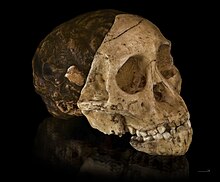Taung Child
 |
|
| Catalog no. | Taung 1 |
|---|---|
| Common name | Taung Child |
| Species | Australopithecus africanus |
| Age | About 2.8 mya and 3.3 years when deceased |
| Place discovered | Taung, South Africa |
| Date discovered | 1924 |
The Taung Child (or Taung Baby) is the fossilised skull of a young Australopithecus africanus. It was discovered in 1924 by quarrymen working for the Northern Lime Company in Taung, South Africa. Raymond Dart described it as a new species in the journal Nature in 1925.
The Taung skull is in repository at the University of Witwatersrand.Dean Falk, a specialist in brain evolution, has called it "the most important anthropological fossil of the twentieth century."
In the early 20th century, the workers at limestone quarries in southern Africa routinely uncovered fossils from the tufa formations they mined. Many were of extinct fauna, which included baboons and other primates, and the more complete or somehow more interesting fossils were kept as curios by the Europeans that managed operations.
In 1924, workers at the Buxton Limeworks near Taung, South Africa, showed a fossilised primate skull to E. G. Izod, the visiting director of the Northern Lime Company, the managing company of the quarry. The director gave it to his son, Pat Izod, who displayed it on the mantle over the fireplace. When Josephine Salmons, a friend of the Izod family, paid a visit to Pat's home, she noticed the primate skull, identified it as from an extinct monkey, and realised its possible significance to her mentor, Raymond Dart.
Josephine Salmons was the first female student of Dart, an anatomist at the University of Witwatersrand. Salmons was permitted to take the fossilised skull and presented it to Dart, who also recognised it as a significant find. Dart asked the company to send any more interesting fossilised skulls that should be unearthed. When a consulting geologist named Robert Young paid a visit to the quarry office, the director, A. E. Speirs, presented him with a collection of fossilised primate skulls that had been gathered by a miner known as Mr. De Bruyn. Young sent some of the skulls back to Dart. When Dart examined the contents of the crate, he found a fossilised endocast of a skull, showing the impression of a complex brain, and matched it to a fossilised skull of a juvenile primate, which had a shallow face and fairly small teeth.
...
Wikipedia
